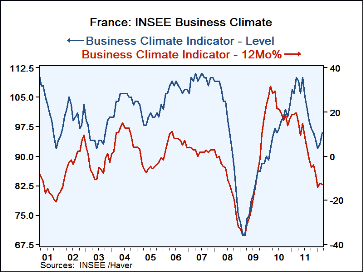 Global| Mar 23 2012
Global| Mar 23 2012French Biz Indicator Turns Up
Summary
The Insee Business climate indicator rose to 96 in March from 92 in February. It's the first increase in the indicator since June of last year. The climate reading is still weak below the midpoint of its high-low range since 1990. Its [...]
 The Insee Business climate indicator rose to 96 in March from 92 in February. It's the first increase in the indicator
since June of last year. The climate reading is still weak below the midpoint of its high-low range since 1990.
Its strongest component standing is only in the 67th percentile. That reading is for the strength in the 'likely
trend for production;' having strength there is a hopeful sign. The 'likely sales price' trend also is above its
mid-point with a range standing of the 57th percentile. Orders and demand and foreign orders and demand are below
their range mid points with percentile readings of less than 50. Recast as percentiles in their ordered queues they
are weaker still, in their 30th to 40th percentiles.
The Insee Business climate indicator rose to 96 in March from 92 in February. It's the first increase in the indicator
since June of last year. The climate reading is still weak below the midpoint of its high-low range since 1990.
Its strongest component standing is only in the 67th percentile. That reading is for the strength in the 'likely
trend for production;' having strength there is a hopeful sign. The 'likely sales price' trend also is above its
mid-point with a range standing of the 57th percentile. Orders and demand and foreign orders and demand are below
their range mid points with percentile readings of less than 50. Recast as percentiles in their ordered queues they
are weaker still, in their 30th to 40th percentiles.
The main good news in the survey is that it did rise this month and some of the components moved quite sharply higher. The 'recent trend' component surged higher to a raw reading of -15 in March from a reading of -27 in February; quite a strong move. The 'recent trend' moved from -2 in Mar. to +6 in Feb. Both overall and foreign orders and demand improved with foreign orders and demand up to -15 in March. from -33 in February.
Some of the components in the Insee survey have moved sharply higher this month. Still, the standing of the various components and the headline is still quite weak. The rest of the Zone is still having a lot of trouble and weakness; Ireland has just slid back into recession, for example. The recent PMIs for MFG and Services for the Zone have moved decidedly lower. Events like that make this survey which reveals a positive trend for France one that seems to stand alone. Is France really reviving? Or, will this note of optimism prove to be fleeting?
France is also in the midst of an election cycle and that could be having some impact on perceptions of the economy is doing.
| INSEE Industry Survey | ||||||||||
|---|---|---|---|---|---|---|---|---|---|---|
| Since Jan 1990 | Since Jan 1990 | |||||||||
| Mar 12 |
Feb 12 |
Jan 12 |
Dec 11 |
%tile | Rank | Max | Min | Range | Mean | |
| Climate | 96 | 92 | 92 | 94 | 46.4 | 176 | 126 | 70 | 56 | 100 |
| Production | ||||||||||
| Recent Trend | -15 | -27 | -35 | -36 | 49.6 | 161 | 43 | -72 | 115 | -8 |
| Likely Trend | 6 | -2 | -5 | 0 | 62.3 | 144 | 29 | -32 | 61 | 6 |
| Orders/Demand | ||||||||||
| Orders & Demand | -23 | -26 | -28 | -26 | 44.0 | 180 | 33 | -67 | 100 | -16 |
| Fgn Orders & Demand | -15 | -33 | -26 | -20 | 49.6 | 157 | 45 | -74 | 119 | -12 |
| Prices | ||||||||||
| Likely Sales Price Trend | 5 | 1 | 2 | 6 | 57.4 | 120 | 28 | -26 | 54 | 3 |
Robert Brusca
AuthorMore in Author Profile »Robert A. Brusca is Chief Economist of Fact and Opinion Economics, a consulting firm he founded in Manhattan. He has been an economist on Wall Street for over 25 years. He has visited central banking and large institutional clients in over 30 countries in his career as an economist. Mr. Brusca was a Divisional Research Chief at the Federal Reserve Bank of NY (Chief of the International Financial markets Division), a Fed Watcher at Irving Trust and Chief Economist at Nikko Securities International. He is widely quoted and appears in various media. Mr. Brusca holds an MA and Ph.D. in economics from Michigan State University and a BA in Economics from the University of Michigan. His research pursues his strong interests in non aligned policy economics as well as international economics. FAO Economics’ research targets investors to assist them in making better investment decisions in stocks, bonds and in a variety of international assets. The company does not manage money and has no conflicts in giving economic advice.






